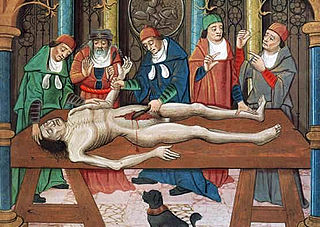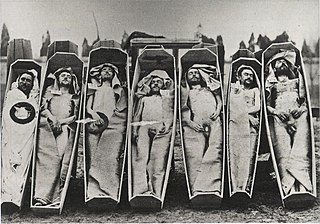Related Research Articles

The history of anatomy extends from the earliest examinations of sacrificial victims to the sophisticated analyses of the body performed by modern anatomists and scientists. Written descriptions of human organs and parts can be traced back thousands of years to ancient Egyptian papyri, where attention to the body was necessitated by their highly elaborate burial practices.

The history of anatomy in the 19th century saw anatomists largely finalise and systematise the descriptive human anatomy of the previous century. The discipline also progressed to establish growing sources of knowledge in histology and developmental biology, not only of humans but also of animals.

The Visible Human Project is an effort to create a detailed data set of cross-sectional photographs of the human body, in order to facilitate anatomy visualization applications. It is used as a tool for the progression of medical findings, in which these findings link anatomy to its audiences. A male and a female cadaver were cut into thin slices, which were then photographed and digitized. The project is run by the U.S. National Library of Medicine (NLM) under the direction of Michael J. Ackerman. Planning began in 1986; the data set of the male was completed in November 1994 and the one of the female in November 1995. The project can be viewed today at the NLM in Bethesda, Maryland. There are currently efforts to repeat this project with higher resolution images but only with parts of the body instead of a cadaver.

The Burke and Hare murders were a series of sixteen killings committed over a period of about ten months in 1828 in Edinburgh, Scotland. They were undertaken by William Burke and William Hare, who sold the corpses to Robert Knox for dissection at his anatomy lectures.

Dissection is the dismembering of the body of a deceased animal or plant to study its anatomical structure. Autopsy is used in pathology and forensic medicine to determine the cause of death in humans. Less extensive dissection of plants and smaller animals preserved in a formaldehyde solution is typically carried out or demonstrated in biology and natural science classes in middle school and high school, while extensive dissections of cadavers of adults and children, both fresh and preserved are carried out by medical students in medical schools as a part of the teaching in subjects such as anatomy, pathology and forensic medicine. Consequently, dissection is typically conducted in a morgue or in an anatomy lab.

Body snatching is the illicit removal of corpses from graves, morgues, and other burial sites. Body snatching is distinct from the act of grave robbery as grave robbing does not explicitly involve the removal of the corpse, but rather theft of the burial site itself. The term 'body snatching' most commonly refers to the removal and sale of corpses primarily for the purpose of dissection or anatomy lectures in medical schools. The term was coined primarily in regard to cases in the United Kingdom and United States throughout the 17th, 18th, and 19th centuries. However, there have been cases of body snatching ranging across a variety of countries, with the first recorded case dating back to 1319 in Bologna, Italy. Those who practiced the act of body snatching and sale of corpses during this period were commonly referred to as "resurrectionists" "resurrection men". Resurrectionists in the United Kingdom who often worked in teams and who primarily targeted more recently dug graves, would be hired in order to provide medical institutions and practitioners with a supply of fresh cadavers for the purpose of anatomical study. Despite a significant decline in body snatching as a practice, there do exist contemporary instances of body snatching cases occurring around the globe.

Robert Knox was a Scottish anatomist and ethnologist best known for his involvement in the Burke and Hare murders. Born in Edinburgh, Scotland, Knox eventually partnered with anatomist and former teacher John Barclay and became a lecturer on anatomy in the city, where he introduced the theory of transcendental anatomy. However, Knox's incautious methods of obtaining cadavers for dissection before the passage of the Anatomy Act 1832 and disagreements with professional colleagues ruined his career in Scotland. Following these developments, he moved to London, though this did not revive his career.

Alexander Monro tertius of Craiglockhart, FRSE FRCPE FSA (Scot) MWS, was a Scottish anatomist and medical educator at the University of Edinburgh Medical School. According to his detractors, Monro was an uninspired anatomist who did not compare with his brilliant father or grandfather as a teacher or scientist. His students included Charles Darwin who asserted that Monro "made his lectures on human anatomy as dull as he was himself."

The Anatomy Act 1832 is an Act of Parliament of the United Kingdom that gave free licence to doctors, teachers of anatomy and bona fide medical students to dissect donated bodies. It was enacted in response to public revulsion at the illegal trade in corpses.

A prosector is a person with the special task of preparing a dissection for demonstration, usually in medical schools or hospitals. Many important anatomists began their careers as prosectors working for lecturers and demonstrators in anatomy and pathology.
Murder for body parts also known as medicine murder refers to the killing of a human being in order to excise body parts to use as medicine or purposes in witchcraft. Medicine murder is viewed as the obtaining of an item or items from a corpse to be used in traditional medicine. Its practice occurs primarily in sub-equatorial Africa.
The London Burkers were a group of body snatchers operating in London, England, who apparently modeled their activities on the notorious Burke and Hare murders. They came to prominence in 1831 for murdering victims to sell to anatomists, by luring and drugging them at their dwelling in the northern end of Bethnal Green, near St Leonard's, Shoreditch in London. They were also known as the Bethnal Green Gang.

An écorché is a figure drawn, painted, or sculpted showing the muscles of the body without skin, normally as a figure study for another work or as an exercise for a student artist. The Renaissance-era architect, theorist and all-around Renaissance man, Leon Battista Alberti, recommended that when painters intend to depict a nude, they should first arrange the muscles and bones, then depict the overlying skin.

Richard Partridge FRS, FRCS was a British surgeon. Although he became President of both the Royal College of Surgeons and the Royal Medical and Chirurgical Society, he is best known for his part in apprehending the London Burkers gang and for failing to spot a bullet lodged in Giuseppe Garibaldi's leg.

A cadaver or corpse is a dead human body that is used by medical students, physicians and other scientists to study anatomy, identify disease sites, determine causes of death, and provide tissue to repair a defect in a living human being. Students in medical school study and dissect cadavers as a part of their education. Others who study cadavers include archaeologists and arts students.

The Medical Renaissance, from around 1400 to 1700 CE, was a period of progress in European medical knowledge, with renewed interest in the ideas of the ancient Greek and Roman civilizations along with Arabic-Persian medicine, following the translation into Latin of many works from these societies. Medical discoveries during the Medical Renaissance are credited with paving the way for modern medicine.

Burke & Hare is a 2010 British black comedy film, loosely based on the Burke and Hare murders of 1828. Directed by John Landis from an original screenplay by Nick Moorcroft and Piers Ashworth, the film stars Simon Pegg and Andy Serkis as William Burke and William Hare respectively. It was Landis's first feature film release in 12 years, the last being 1998's Susan's Plan. The film was released in the United Kingdom on 29 October 2010.

Resurrectionists were body snatchers who were commonly employed by anatomists in the United Kingdom during the 18th and 19th centuries to exhume the bodies of the recently dead. Between 1506 and 1752 only a very few cadavers were available each year for anatomical research. The supply was increased when, in an attempt to intensify the deterrent effect of the death penalty, Parliament passed the Murder Act 1752. By allowing judges to substitute the public display of executed criminals with dissection, the new law significantly increased the number of bodies anatomists could legally access. This proved insufficient to meet the needs of the hospitals and teaching centres that opened during the 18th century. Corpses and their component parts became a commodity, but although the practice of disinterment was hated by the general public, bodies were not legally anyone's property. The resurrectionists therefore operated in a legal grey area.
The Pennsylvania Anatomy Act of 1883 is legislation of the State of Pennsylvania to facilitate medical education. This act allowed teachers and students to be able to dissect bodies without have to resort to buying from grave robbers or buying body parts. This act was written to prevent grave robbing, and to even out the availability of corpses.
As anatomy classes in medical education proliferated in the 19th century, so too did the need for bodies to dissect. Grave robbery proliferated, along with associated social discontent, revulsion, and unhappiness. Conflicts arose between medical practitioners and defenders of bodies, graves and graveyards. This resulted in riots. Social legislation was passed in many countries to address the competing concerns.
References
- ↑ Katherine Park (1994), "The Criminal and the Saintly Body: Autopsy and Dissection in Renaissance Italy" Renaissance Quarterly, Vol. 47, No. 1, pp. 1-33
- ↑ Don Shelton (2010),"The Emperor's new clothes" Journal of the Royal Society of Medicine,103:46-50, 166-7, 205-6
- ↑ http://edinburghsdarkside.blogspot.com/2007/04/helen-torrence-and-jean-waldie.html [ user-generated source ]
- ↑ Lisa Rosner (2010), The Anatomy Murders. University of Pennsylvania Press
- ↑ Ruth Richardson (2001). Death, Dissection, and the Destitute. University of Chicago Press.
- ↑ Sherwin Nuland (2001), "The Edinburgh Anatomy Murders" "CUMC Surgery Residency - Grand Rounds". Archived from the original on 2011-06-10. Retrieved 2010-06-14.
- ↑ Sarah Wise (2004). The Italian Boy. Metropolitan Books.
- ↑ Mary Roach (2003). Stiff. W.W. Norton.
- ↑ "Corpse-selling case outrages Colombians Police say homeless slain to get bodies for med school | Dave MarcusDave Marcus". Archived from the original on 2011-07-08. Retrieved 2010-06-14.
- ↑ "Anatomy Laws V. Body-Snatching" (1896). British Medical Journal Vol. 2, No. 1878, p. 1845
- ↑ Colin Evans (2007), The Casebook of Forensic Investigation. Berkley Trade.